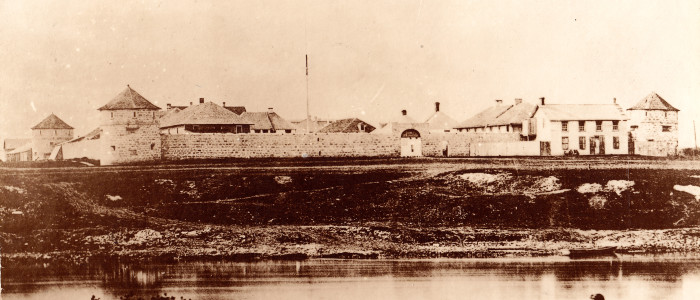The Red and Assiniboine rivers were the lifeblood of communities in Red River during the fur trade period. They provided inhabitants with a means of transportation, a source of water, and contributed to the sustainment of abundant natural resources. However, as present-day Manitobans know, the rivers can cause a lot of trouble come springtime. Every year, accumulated snow and ice melt, causing the rivers to rise. Sometimes, these rising waters spill over the riverbanks, causing damage to nearby homes and structures. Today, changes in the rivers are closely monitored and mediated by floodgates. However, in the 19th century, inundations posed a more unpredictable threat. The infamous flood of 1826 destroyed the original Upper Fort Garry. In 1852, another, terrible flood ravaged the plains of Red River, damaging hundreds of homes, and even reaching the walls of Upper Fort Garry.
The flood in 1852 was caused by heavy snowfall in March and cool temperatures in April that quickly transitioned into warm weather and rain while river waters rose. The waters rose quickly and suddenly – people had to flee their homes for higher ground such as at Stony Mountain, Bird’s Hill, or Sturgeon Creek. While these folk fled and took refuge, they suffered incredible loss of livelihood and property. Many Red River settlers wrote accounts of this flood and its consequences. One such person, Alexander Ross, provides a very vivid account:
“On the 7th of May, the water has risen eight feet above the high water mark of ordinary years, overflowed the banks of the river and began to spread devastation and ruin in the settlement: boats and canoes in great request for the saving of lives and property. All hurry, bustle, and confusion. Some had to take shelter in the garrets, some on stages, some here, some there, in little groups, on spots higher than the rest, anxiously waiting a boat, a canoe, or some friendly hand to save them from a watery grave. From 150 yards wide, the usual breadth of the river, it had spread to three miles on each side, and rose for several days at the rate of nearly an inch per hour.
On the 12th, half the colony was under water… so low and flat is the country throughout, that not a single house was excepted – all was submerged – not an inhabitant but had fled. The crying of children, lowing of cattle, squealing of pigs, and howling of dogs completed the strange and melancholy scene.




